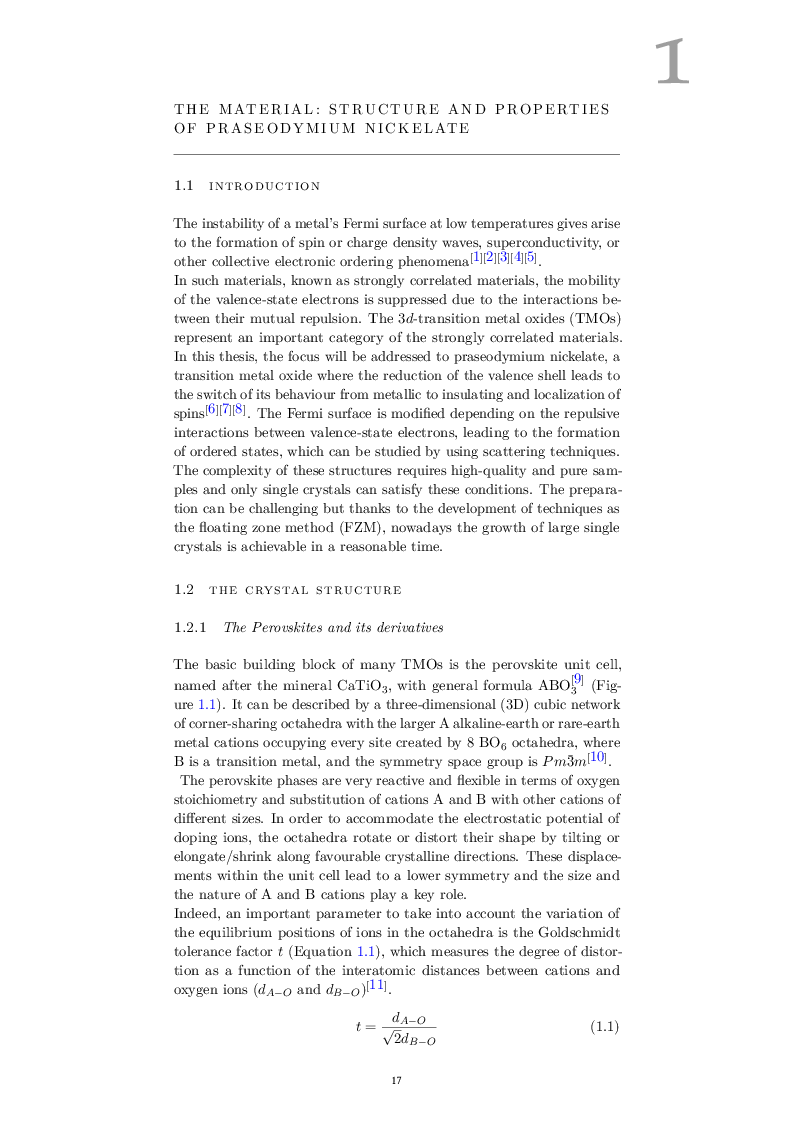Long-range Ordering in Pr(2)NiO(4+δ) Single Crystals studied by Resonant Soft X-Ray Scattering
Lanthanide oxides with the general formula of Ln2MO4+δ (where Ln = La, Pr, Nd and M = Cu, Ni, Co) are a class of perovskite oxides being part of the K2NiF4 family. As strongly correlated materials, their properties vary drastically on temperature and doping; the latter can extend over a wide range of concentration, modifying (anisotropic) oxygen mobility and valence states of the ions.
The chosen material to be investigated is Pr2NiO4+δ. Below certain critical temperatures, besides the antiferromagnetism, three- and/or two-dimensional long-range ordered superstructures can arise, creating electronically correlated states that only oxygen intercalation can induce. Those modulations are commonly referred to as static and dynamic orbital-, spin- and charge-stripe phases, i.e. wide local AFM regions divided by narrow anti-phase boundaries. They can be observed as commensurate and/or incommensurate diffrac- tion peaks by using high-brilliance X-ray sources, like synchrotron. However, their interpretation is challenging and their origin can be often confusing, due to their low intensity with respect to the structural Bragg peaks by a factor of 10−4 and the surface and bulk defects of the material, e.g. NiO segregation or Pr6O11 hydrolization. These elements provided the motivation to grow large single crystals
of Pr2NiO4+δ, in order to carry out analyses by exploiting resonant soft x-ray scattering (RSXS), a powerful technique which enhance the intensity of satellite reflections arising from competing states. By scattering with photon energies on resonance of the element’s elec- tronic transitions, RSXS is an element-specific, sensitive tool providing a combination of spectroscopic and spatial information. The thesis fo- cuses on the energy-, temperature- and polarization-dependent analysis of the ordered states measured.
CONSULTA INTEGRALMENTE QUESTA TESI
La consultazione è esclusivamente in formato digitale .PDF
Acquista

CONSULTA INTEGRALMENTE QUESTA TESI
La consultazione è esclusivamente in formato digitale .PDF
Acquista
Informazioni tesi
| Autore: | Francesco D'Acierno |
| Tipo: | Tesi di Laurea Magistrale |
| Anno: | 2014-15 |
| Università: | Université de Montpellier |
| Facoltà: | Scienze Matematiche, Fisiche e Naturali |
| Corso: | Chimica dei Materiali & Processi per l'Energia e lo Sviluppo Sostenibile |
| Relatore: | Werner Paulus |
| Lingua: | Inglese |
| Num. pagine: | 86 |
Forse potrebbe interessarti la tesi:
Qual è il confine tra doping e non doping. Ruolo dell'infermiere nella prevenzione e tutela della salute
FAQ
Come consultare una tesi
Il pagamento può essere effettuato tramite carta di credito/carta prepagata, PayPal, bonifico bancario.
Confermato il pagamento si potrà consultare i file esclusivamente in formato .PDF accedendo alla propria Home Personale. Si potrà quindi procedere a salvare o stampare il file.
Maggiori informazioni
Perché consultare una tesi?
- perché affronta un singolo argomento in modo sintetico e specifico come altri testi non fanno;
- perché è un lavoro originale che si basa su una ricerca bibliografica accurata;
- perché, a differenza di altri materiali che puoi reperire online, una tesi di laurea è stata verificata da un docente universitario e dalla commissione in sede d'esame. La nostra redazione inoltre controlla prima della pubblicazione la completezza dei materiali e, dal 2009, anche l'originalità della tesi attraverso il software antiplagio Compilatio.net.
Clausole di consultazione
- L'utilizzo della consultazione integrale della tesi da parte dell'Utente che ne acquista il diritto è da considerarsi esclusivamente privato.
- Nel caso in cui l’utente che consulta la tesi volesse citarne alcune parti, dovrà inserire correttamente la fonte, come si cita un qualsiasi altro testo di riferimento bibliografico.
- L'Utente è l'unico ed esclusivo responsabile del materiale di cui acquista il diritto alla consultazione. Si impegna a non divulgare a mezzo stampa, editoria in genere, televisione, radio, Internet e/o qualsiasi altro mezzo divulgativo esistente o che venisse inventato, il contenuto della tesi che consulta o stralci della medesima. Verrà perseguito legalmente nel caso di riproduzione totale e/o parziale su qualsiasi mezzo e/o su qualsiasi supporto, nel caso di divulgazione nonché nel caso di ricavo economico derivante dallo sfruttamento del diritto acquisito.
Vuoi tradurre questa tesi?
Per raggiungerlo, è fondamentale superare la barriera rappresentata dalla lingua. Ecco perché cerchiamo persone disponibili ad effettuare la traduzione delle tesi pubblicate nel nostro sito.
Per tradurre questa tesi clicca qui »
Scopri come funziona »
DUBBI? Contattaci
Contatta la redazione a
[email protected]
Parole chiave
Tesi correlate
Non hai trovato quello che cercavi?
Abbiamo più di 45.000 Tesi di Laurea: cerca nel nostro database
Oppure consulta la sezione dedicata ad appunti universitari selezionati e pubblicati dalla nostra redazione
Ottimizza la tua ricerca:
- individua con precisione le parole chiave specifiche della tua ricerca
- elimina i termini non significativi (aggettivi, articoli, avverbi...)
- se non hai risultati amplia la ricerca con termini via via più generici (ad esempio da "anziano oncologico" a "paziente oncologico")
- utilizza la ricerca avanzata
- utilizza gli operatori booleani (and, or, "")
Idee per la tesi?
Scopri le migliori tesi scelte da noi sugli argomenti recenti
Come si scrive una tesi di laurea?
A quale cattedra chiedere la tesi? Quale sarà il docente più disponibile? Quale l'argomento più interessante per me? ...e quale quello più interessante per il mondo del lavoro?
Scarica gratuitamente la nostra guida "Come si scrive una tesi di laurea" e iscriviti alla newsletter per ricevere consigli e materiale utile.
La tesi l'ho già scritta,
ora cosa ne faccio?
La tua tesi ti ha aiutato ad ottenere quel sudato titolo di studio, ma può darti molto di più: ti differenzia dai tuoi colleghi universitari, mostra i tuoi interessi ed è un lavoro di ricerca unico, che può essere utile anche ad altri.
Il nostro consiglio è di non sprecare tutto questo lavoro:
È ora di pubblicare la tesi

